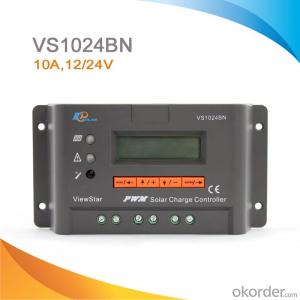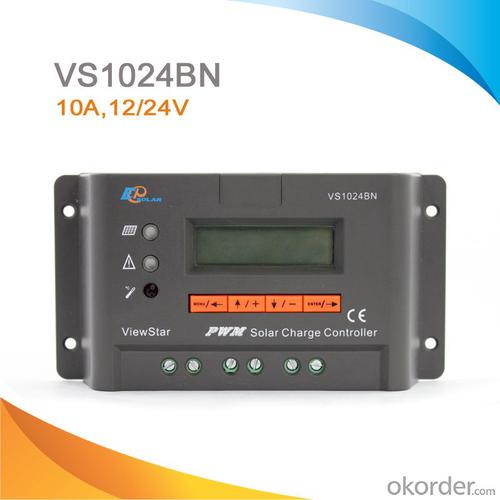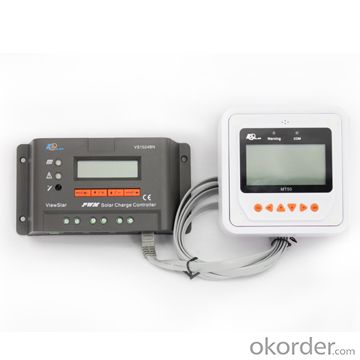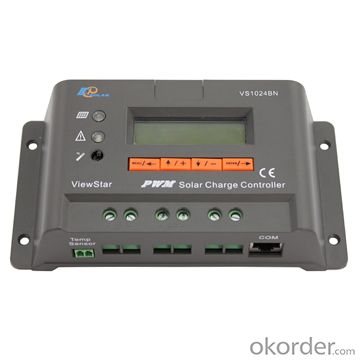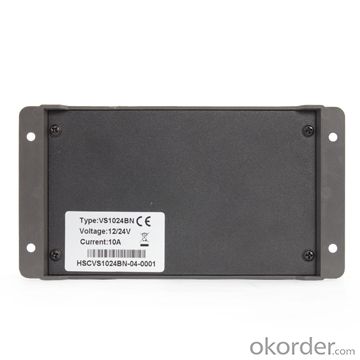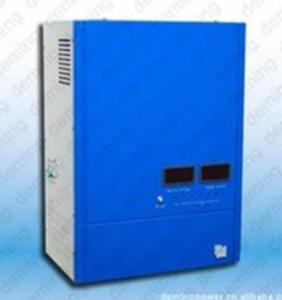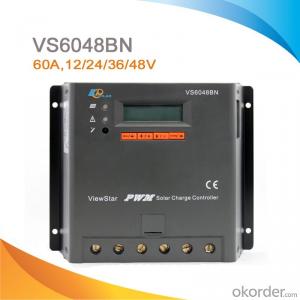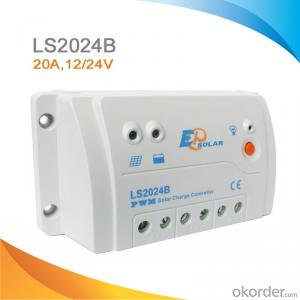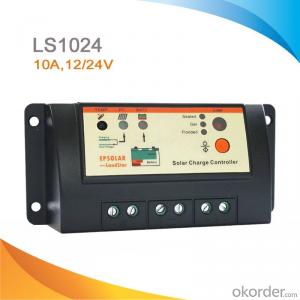60 Amp Intelligent PWM Solar Charge Controller for Solar Street Light, 12V/24V, VS1024BN
- Loading Port:
- China main port
- Payment Terms:
- TT or LC
- Min Order Qty:
- -
- Supply Capability:
- -
OKorder Service Pledge
OKorder Financial Service
You Might Also Like
Features:
·Excellent EMC design
·32 bit MCU with high speed
·High efficient Series PWM charging
·Four battery type options: Sealed, Gel, Flooded, and USER
·Intelligent lighting and timer control for solar lighting system
·12 bit A/D high-precision sampling to ensure accuracy
·Use MOSFET as electronic switch
·Full control parameters setting and modification, diversified load control mode
·Humanized design of browser interface, undertake every operating conveniently
·Temperature compensation
·Adopt graphics dot-matrix LCD screen and HMI (human-machine interface) with 4 buttons,integrated menu displaying and operation
·Energy statistics function
·RS485 ports with MODBUS communication protocol
·Optional PC monitoring software and remote meter for real-time monitoring and battery management parameter setting
·Field upgradable firmware
Specification:
Model | VS1024BN | VS2024BN | VS3024BN | VS4524BN | VS6024BN |
Nominal system voltage | 12V/24V auto work | ||||
Rated battery current | 10A | 20A | 30A | 45A | 60A |
Rated load current | 10A | 20A | 30A | 45A | 60A |
Max. battery voltage | 32V | ||||
Equalize charging voltage | Sealed: 14.6V, Flooded: 14.8V, User-defined: 9~17V | ||||
Boost charging voltage | Gel: 14.2V, Sealed: 14.6V, Flooded: 14.8V, User-defined: 9~17V | ||||
Float charging voltage | Gel /Sealed /Flooded: 13.8V, User-defined: 9~17V | ||||
Low voltage reconnect voltage | Gel /Sealed /Flooded: 12.6V, User-defined: 9~17V | ||||
Low voltage disconnect voltage | Gel /Sealed /Flooded: 11.1V, User-defined: 9~17V | ||||
Self-consumption | ≤15mA(12V); ≤10mA(24V); ≤9mA(36V); ≤8mA(48V) | ||||
Grounding | Common negative | ||||
Temp. compensation | -3mV/°C/2V | ||||
Relative humidity | 10%~90% Non-condensation | ||||
Communication | RS485 / RJ45 interface | ||||
LCD temperature | -20°C ~ +70°C | ||||
Working temperature | -25°C ~ +55°C | ||||
Humidity | ≤95% N.C. | ||||
Enclosure | IP30 | ||||
Overall dimension | 162x85x40mm | 162x100x50mm | 200x103x58mm | 201x109x59mm | 205x129x67mm |
Terminals | 4mm2 | 10mm2 | 16mm2 | 35mm2 | 35mm2 |
Net weight | 0.2kg | 0.4kg | 0.7kg | 0.9kg | 1.3kg |
Warrenty
provides a 1~3 year limited warranty (“Warranty”) against defects in materials and workmanship for its Uninterruptible power supply,
Power inverter/chargers, Solar charge controllers, Battery Products (“Product”).
The term of this Warranty begins on the Product(s) initial purchase date, or the date of receipt of the Product(s) by the end user,
whichever is later. This must be indicated on the invoice, bill of sale, and/or warranty registration card submitted to MUST-Solar.
This Warranty applies to the original MUST-Solar Product purchaser, and is transferable only if the Product remains installed in the original use location.
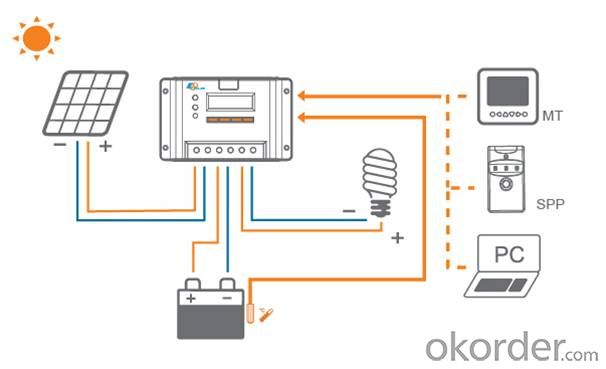
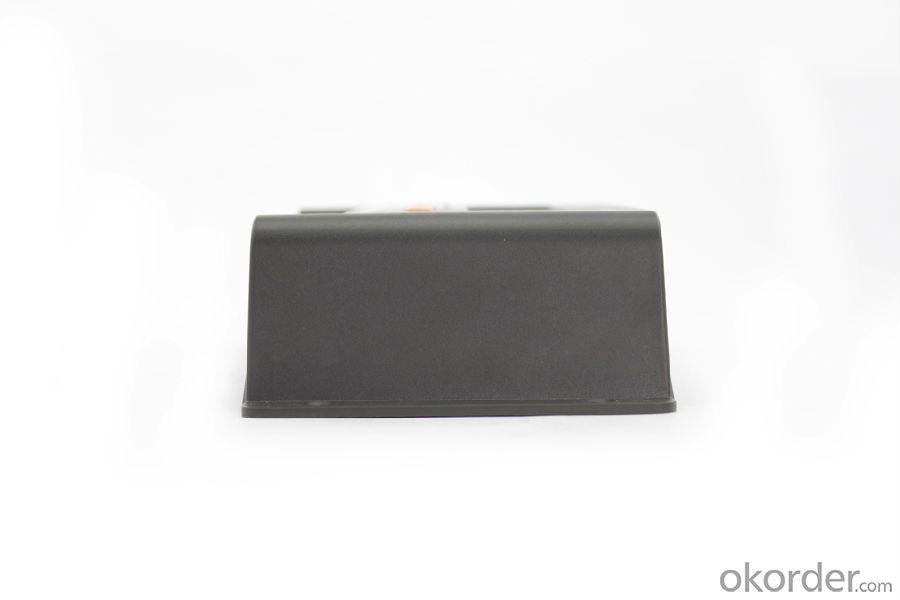

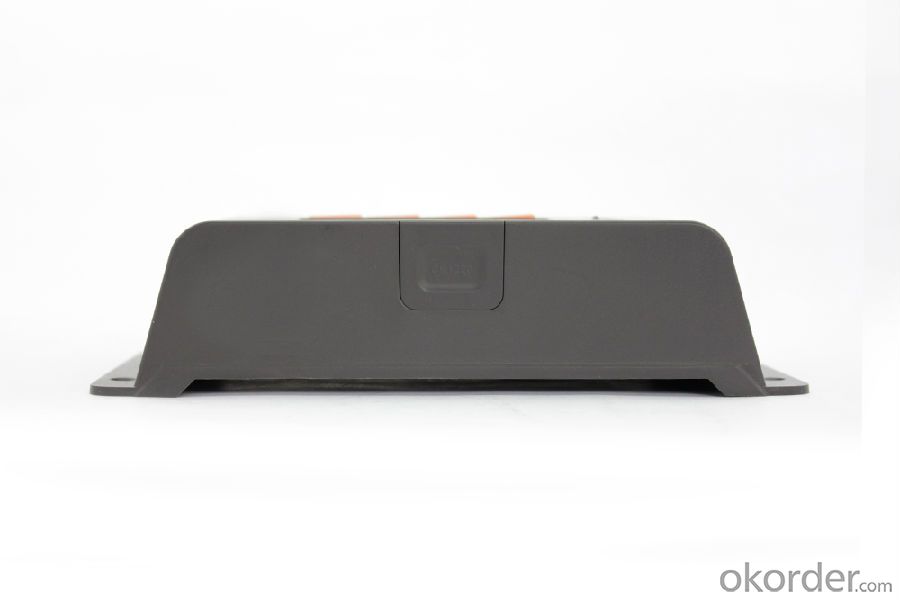
FAQ:
Q1. What is the voltage?
A1. Our 45/60A solar charge controller is 12/24/36/48V auto work.
Q2. What is the difference between MPPT&PWM?
A2. MPPT has higher efficiency, it can track the max power point and won't waste energy.
Q3. What is the efficiency of the MPPT controller?
A3. MPPT>99%, peak conversion efficiency>98%.
Q4. What is the waranty of product?
A4. 12 months.
Q5. What protection does your MPPT controller have?
A5. PV array short circuit, PV reverse polarity, Battery reverse polarity, Over charging, Output short circuit.
- Q: What is the installation process for a solar controller?
- The installation process for a solar controller typically involves a few simple steps. Firstly, you need to mount the controller in a suitable location near the solar panels and battery bank. The controller should be placed where it is easily accessible for monitoring and maintenance. Next, you will need to connect the solar panels to the controller. This usually involves connecting the positive and negative wires from the solar panels to the corresponding terminals on the controller. After that, you will need to connect the battery bank to the controller. Similar to the solar panel connection, you will need to connect the positive and negative wires from the battery bank to the appropriate terminals on the controller. Finally, you will need to connect any additional components, such as inverters or load terminals, to the controller if required. It is crucial to follow the manufacturer's instructions and safety guidelines during the installation process. It is also recommended to consult with a professional or an electrician if you are unsure or unfamiliar with electrical installations.
- Q: Can a solar controller be used in a solar-powered cruise ship?
- Yes, a solar controller can be used in a solar-powered cruise ship. A solar controller is an essential component that regulates the amount of energy flowing from solar panels to the battery bank. In a solar-powered cruise ship, the solar controller helps optimize energy production and prevent overcharging of the batteries, ensuring efficient and safe operation of the ship's solar power system.
- Q: Can a solar controller be used with solar-powered electric fences for wildlife conservation?
- Yes, a solar controller can be used with solar-powered electric fences for wildlife conservation. A solar controller helps regulate the flow of electricity from the solar panels to the electric fence, ensuring that the fence receives the necessary power while preventing overcharging or damage to the system. By using a solar controller, the electric fence can effectively deter wildlife and protect conservation areas in a sustainable and environmentally friendly manner.
- Q: Can a solar controller be used with a solar-powered electric fence?
- Yes, a solar controller can be used with a solar-powered electric fence. The solar controller is responsible for regulating the charging and discharging of the solar battery that powers the fence. It ensures that the battery is charged efficiently and prevents overcharging or discharging.
- Q: What is the maximum solar panel capacity that a solar controller can handle?
- The maximum solar panel capacity that a solar controller can handle varies depending on the specific model and manufacturer. However, most standard solar controllers can handle capacities ranging from 10 to 60 amps, which typically corresponds to solar panel capacities of around 100 to 600 watts. It is crucial to check the specifications of the particular solar controller to determine its maximum capacity and ensure compatibility with the solar panel system.
- Q: How do I determine the maximum load output power for a solar controller?
- To determine the maximum load output power for a solar controller, you need to refer to the specifications provided by the manufacturer. The maximum load output power is typically stated in the product manual or datasheet. It is important to check for the maximum load output power rating to ensure that it can handle the power requirements of your specific load or device.
- Q: Can a solar controller be used with solar-powered indoor industrial buildings?
- Solar controllers, also known as charge controllers, are necessary components in solar power systems. They regulate the voltage and current from solar panels, preventing battery overcharging and ensuring efficient charging. In solar-powered indoor industrial buildings, the solar controller plays a crucial role in managing electricity flow. It optimizes energy production and delivery to power various equipment and systems within the building. The solar controller ensures proper battery charging and maintains a stable power supply. It safeguards batteries from damage caused by overcharging or excessive discharge, increasing their lifespan and system efficiency. Moreover, solar controllers offer monitoring and control capabilities. Users can track solar panel and battery performance, optimizing energy usage, identifying issues, and making informed decisions to enhance overall efficiency. Overall, solar controllers are indispensable for managing and optimizing solar power systems, making them suitable for solar-powered indoor industrial buildings.
- Q: Can a solar controller be used with solar-powered indoor retail facilities?
- Solar controllers can be utilized in solar-powered indoor retail facilities. Regardless of the setting, a solar controller remains a crucial component of a solar power system. Its primary function is to regulate the electricity flow from the solar panels to the batteries, ensuring efficient charging and preventing overcharging or damage. Thus, even in solar-powered indoor retail facilities, a solar controller is indispensable for managing the electricity generated by the solar panels. It guarantees the proper storage and utilization of this electricity to power the facility's lighting, appliances, and other electrical equipment.
- Q: Can a solar controller be used in a solar-powered emergency backup system?
- Yes, a solar controller can be used in a solar-powered emergency backup system. A solar controller is an essential component that regulates the charging and discharging of batteries in a solar system. In an emergency backup system, it helps manage the flow of power from the solar panels to the batteries, ensuring efficient charging and preventing overcharging or damage. By controlling the power flow, the solar controller helps maintain the reliability and longevity of the backup system, making it an important component in solar-powered emergency backup setups.
- Q: How do I integrate a solar controller with my existing solar system?
- To integrate a solar controller with your existing solar system, you will need to follow these steps: 1. Determine the compatibility: Check if the solar controller you have is compatible with your existing solar panels and inverter. Look for specifications such as voltage and current ratings to ensure a proper match. 2. Disconnect power: Before making any connections, make sure to disconnect the power supply to your solar system to avoid any accidents. 3. Locate the existing system components: Identify the location of your solar panels, inverter, battery bank (if applicable), and any existing charge controller. This will help you plan the integration process effectively. 4. Mount the solar controller: Choose an appropriate location to mount the solar controller near your existing system components. Ensure it is easily accessible and well-ventilated. 5. Connect the solar controller: Connect the solar panel wires to the solar controller's input terminals, following the manufacturer's instructions. Ensure proper polarity and tight connections. If you have multiple solar panels, they may need to be wired in series or parallel configurations, depending on the solar controller requirements. 6. Connect the output: Connect the solar controller's output terminals to the input terminals of your existing charge controller or inverter. Again, follow the manufacturer's guidelines for proper wiring and polarity. 7. Reconnect power: Once all connections are made, reconnect the power supply to your solar system. 8. Configure the solar controller: Depending on the model, you may need to configure the solar controller settings for optimal performance. Consult the user manual for specific instructions. 9. Monitor and test: Monitor your solar system's performance after integrating the solar controller. Ensure that the controller is functioning correctly and that your system is operating efficiently. If you are unsure about any step or lack experience with electrical installations, it is recommended to consult a professional electrician or solar installer for assistance to ensure a safe and successful integration process.
Send your message to us
60 Amp Intelligent PWM Solar Charge Controller for Solar Street Light, 12V/24V, VS1024BN
- Loading Port:
- China main port
- Payment Terms:
- TT or LC
- Min Order Qty:
- -
- Supply Capability:
- -
OKorder Service Pledge
OKorder Financial Service
Similar products
Hot products
Hot Searches
Related keywords
